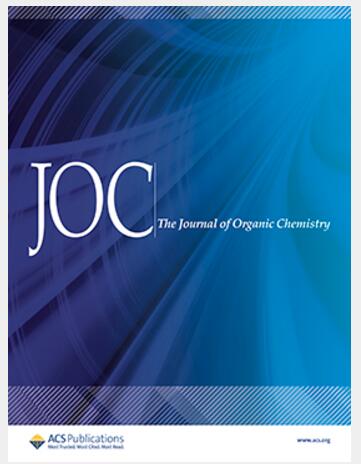一类螺旋bn -纳米石墨烯:杂合咔唑氮杂硼二聚体的系统合成、结构和性能。
IF 3.6
2区 化学
Q1 CHEMISTRY, ORGANIC
引用次数: 0
摘要
用相邻的硼氮(B-N)取代两个碳原子可以显著改善螺旋多环芳烃的光物理性质,但由于结构-性能关系不发达,相关报道仍然很少。本文报道了一类新型螺旋bn纳米石墨烯的合成及其物理化学性质。以合理设计的前驱体为关键步骤,通过双亲电硼化反应,合成了与n -丁基吡咯(1a)、n -苯基吡咯(1b)、呋喃(2)、噻吩(3a)、硒苯(4)和噻吩s -二氧化氮(5)融合的咔唑氮杂啉二聚体。还合成了末端取代基比3a小的噻吩熔接3b和3c。中心杂杂对材料的电化学和光物理性质有明显的影响,并伴有1a、1b和2的强发射,荧光量子产率为0.51 ~ 0.56。末端取代基的体积对溶液性质的影响可以忽略不计,但在固体状态下对晶体的排列方式和荧光性质有显著影响。通过理论计算,讨论了结构对电子结构的影响。本文章由计算机程序翻译,如有差异,请以英文原文为准。
A Family of Helical BN-Nanographenes: Systematic Synthesis, Structures, and Properties of Heterole-Fused Carbazole Azaborine Dimers.
Replacing two carbon atoms with neighboring boron-nitrogen (B-N) units in helical polycyclic aromatic hydrocarbons can substantially improve the photophysical properties, whereas the reports have remained scarce with underdeveloped structure-property relationships. We herein report the synthesis and physicochemical properties of a series of heterole-fused dimers of carbazole-containing azaborines as a new family of helical BN-nanographenes. We synthesized the carbazole azaborine dimers fused with N-butylpyrrole (1a), N-phenylpyrrole (1b), furan (2), thiophene (3a), selenophene (4), and thiophene S-dioxide (5) via double electrophilic borylation of rationally designed precursors as a key step. Thiophene-fused 3b and 3c bearing smaller terminal substituents than 3a were also synthesized. The central heterole had distinct effects on the electrochemical and photophysical properties, accompanied by strong emission of 1a, 1b, and 2 with fluorescence quantum yields of 0.51-0.56. The bulkiness of the terminal substituents had negligible effects on the properties in solution but markedly affected the crystal packing mode and fluorescence properties in the solid state. The structural effects on the electronic structures were also discussed with the aid of theoretical calculations.
求助全文
通过发布文献求助,成功后即可免费获取论文全文。
去求助
来源期刊

Journal of Organic Chemistry
化学-有机化学
CiteScore
6.20
自引率
11.10%
发文量
1467
审稿时长
2 months
期刊介绍:
Journal of Organic Chemistry welcomes original contributions of fundamental research in all branches of the theory and practice of organic chemistry. In selecting manuscripts for publication, the editors place emphasis on the quality and novelty of the work, as well as the breadth of interest to the organic chemistry community.
 求助内容:
求助内容: 应助结果提醒方式:
应助结果提醒方式:


